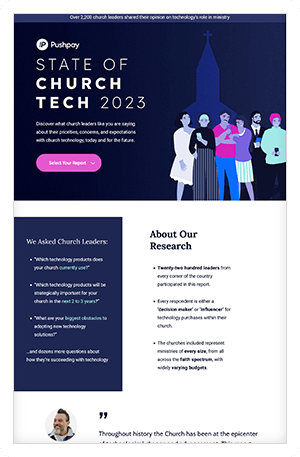The Defining Church Tech Trend of 2023 Will Be Refinement
Updated February 21, 2024 |
I joined Pushpay more than seven years ago, with a passion to help churches and not-for-profit organizations increase connection and belonging in their communities. We have certainly grown and evolved as a company since I started, but our mission and vision for the Church has remained in focus. I can tell you, that seeing churches and leaders succeed continues to be what gets me out of bed every morning. Amplifying the mission of the Church will always be the pulsing heart of our passionate team, the north star that guides everything we create in our mission to serve ministries.
Molly Matthews, CEO
These past several years have been uniquely eventful in the church technology space. The COVID pandemic demanded that churches adopt digital solutions to maintain connection and community amidst social distancing restrictions. At Pushpay, we’ve always believed in technology’s ability to support the mission of the Church (obviously!), but the unprecedented rush on tech created a new need and opportunity for churches and businesses alike.
In late 2021, on the tail end of the COVID restrictions and following the dramatic shifts in our industry, our team was desperate to understand church leaders’ new relationship with tech. But we couldn’t find a wide-reaching study that truly captured the technology needs, concerns, and expectations of churches around the country at this critical moment in time.
State of
Church Tech
Discover what church leaders like you are saying about their priorities, concerns, and expectations with church technology, today and for the future.

So we rolled up our sleeves and created one ourselves. The result was our first annual State of Church Technology report.
The data confirmed what I’ve always believed: digital tools are a powerful complement to ministry. By necessity or otherwise, churches have embraced tech’s ability to fuel their ministry—and you can imagine my relief at seeing hard data that confirmed the vast majority of churches had no intention of abandoning their tools in the future.
Because we saw the tremendous value generated by that inaugural report—both for churches and our internal team—we’ve deemed it an annual benchmark study. And once again, the 2023 State of Church Tech report deftly unveils the current and emerging trends of church leaders all over the country.
A lot of the data stayed the same. 94% of churches claim that technology is important to their mission, and 53% define their ministry as “progressive” when it comes to tech. But what most intrigued me were the subtle shifts in patterns that suggest how the Church’s relationship with tech will evolve in the short and long term.
Church tech isn’t going anywhere, that much is clear. But the dynamics between providers and leaders are changing. This year will be defined by refinement in the digital space.
The pandemic-driven rush to adopt technology is over. Leaders are no longer hurrying to acquire more tools; they’re applying the lessons learned over the past few years and are thoughtfully, patiently identifying the best digital fits for their ministry.
That pattern is apparent throughout the report, but a few trends in particular stood out.
Church-Specific Tools
By every metric, hybrid church is here to stay. 89% of churches continue to embrace a model of ministry that blends in-person and online engagement.
What caught my eye, however, was which digital solutions churches are leaning into. Our survey listed twenty of the most popular church tech tools on the market, and asked respondents which they were currently using. Nineteen of those tools either stayed at the same level of usage, or dropped a few points versus last year’s report—which wasn’t surprising. Our team expected that the utilization of tech would dip slightly after the pandemic.
But one tool actually jumped in usage: Church and Donor Management Software. The utilization and demand for a streamlined, integrated ChMS is up significantly from our first report.
This meshes with the fact that, despite the tidal wave of enthusiasm for tech, 86% of churches report that they don’t want more tools. My conclusion is that churches don’t want more tech—they want great, purpose-built tech.
And speaking of purpose-built…
Livestreaming
Honestly, it’s difficult to temper my excitement for this next trend, because it aligns so perfectly with how Pushpay is evolving.
89% of churches currently livestream worship services. Of those churches, 91% currently do so on social media, but about half embed streams on their website, and over a third are using event hosting platforms and/or a mobile app player.
But when our survey asked where churches planned to livestream a year from now, only 47% said they’d use social media. That means nearly half of all streaming churches are planning to move away from social.
To be clear, the vast majority of churches that currently livestream say they’ll continue to do so. They remain enthusiastic about streaming’s ability to engage people wherever they’re at. But those churches have also discovered that they don’t want to direct viewers to platforms they don’t control. What’s the point of linking a Facebook clip if the viewer will click into their friend’s status update a moment later? Why send users to Youtube if they’re immediately pressured into watching a cat video?
We’re on the brink of a major shift toward custom video players, website embeds, mobile app streaming, and other platforms that are better suited to driving church engagement. This makes our recent addition of Resi Media to our product portfolio feel all the more poignant, as they’re leading the charge in exploring what’s possible for churches that livestream.
Molly Matthews
Barriers to Adoption
Churches will always be limited by resources. There’s so much amazing, necessary work to do in communities, and never enough time or money to accomplish everything you wish you could. With church tech, this creates a bit of a paradox: digital solutions can save your team time, boost generosity, and elevate so many aspects of your ministry—but adopting and implementing those solutions requires an upfront investment of precious resources.
This year’s report showed that cost is more front-of-mind for churches than ever before. The amount of time it might take to implement new tech tools also remains a huge concern. And coming into 2023, the data shows that a tremendous number of churches aren’t 100% sure what their church may look like next year, be it in-person only, online only, or a hybrid model.
Amid all that uncertainty—or perhaps because of it—we identified another trend in the data. When asked which factors were “extremely important” when considering new software products, churches reported a marked increase in the desire for a help desk, dedicated support person, and a self-service help center.
That tells me that church leaders aren’t just looking for a technology provider—they’re looking for a technology partner. Which I absolutely love.
Our Pushpay team, working out of five different offices and remotely from all over the globe, constantly strives to be more than a provider of digital tools; we want to march alongside ministries, to support their great work every step of the way. To collaborate, explore, and innovate together to further the mission of the Church.
That’s the spirit of our State of Church Tech report. Take a look if you haven’t yet; there are so many more valuable insights than the few I’ve discussed here. It’s a powerful tool—for both your church and our team here at Pushpay—that will help us achieve our shared goal of building community, connection, and belonging in 2023 and beyond.
State of
Church Tech
Discover what church leaders like you are saying about their priorities, concerns, and expectations with church technology, today and for the future.

Featured Content
You May Also Like
